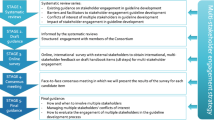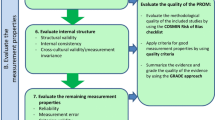Abstract
A disparity between evidence and practice in the management of ischemic heart disease is frequently observed. Guideline adherence and clinical outcomes are influenced by system, provider, and patient factors. Recently, performance improvement measures for cardiovascular disease have gained a lot of popularity worldwide. These measures may facilitate the uptake of evidence-based recommendations and improve patient outcomes. While apparently valid as quality metrics, their impacts on clinical outcomes remain limited and are areas of further research. Several methods for optimizing performance have been instituted and essentially involve three different approaches—improvement in the reporting of data on guideline adherence, providing infrastructure and tools, and providing incentives to improve guideline adherence. Public reporting of quality metrics and “pay-for-performance” are some novel performance improvement tools. The impact of these approaches on patient outcomes will be pivotal in improving cardiovascular outcomes in the future.
Similar content being viewed by others
Abbreviations
- IHD:
-
Ischemic heart disease
- CAD:
-
Coronary artery disease
- AMI:
-
Acute myocardial infarction
- NSTE ACS:
-
Non-ST-segment elevation acute coronary syndromes
References
Papers of particular interest, published recently, have been highlighted as: • Of importance •• Of major importance
Xian Y, Pan W, Peterson ED, et al. Are quality improvements associated with the Get With The Guidelines-Coronary Artery Disease (GWTG-CAD) program sustained over time? A longitudinal comparison of GWTG-CAD hospitals versus non-GWTG-CAD hospitals. Am Heart J. 2010;159:207–14.
Fihn SD, Blankenship JC, Alexander KP,et al. 2014 ACC/AHA/AATS/PCNA/SCAI/STS Focused Update of the Guideline for the Diagnosis and Management of Patients With Stable Ischemic Heart Disease: A Report of the American College of Cardiology/American Heart Association Task Force on Practice Guidelines, and the American Association for Thoracic Surgery, Preventive Cardiovascular Nurses Association, Society for Cardiovascular Angiography and Interventions, and Society of Thoracic Surgeons. J Am Coll Cardiol. 2014;S0735-1097(14)04510-0.
Cannon CP, Brindis RG, Chaitman BR, et al. 2013 ACCF/AHA key data elements and definitions for measuring the clinical management and outcomes of patients with acute coronary syndromes and coronary artery disease: a report of the American College of Cardiology Foundation/American Heart Association Task Force on clinical data standards (writing committee to develop acute coronary syndromes and coronary artery disease clinical data standards). J Am Coll Cardiol. 2013;61:992–1025.
Frolkis JP, Zyzanski SJ, Schwartz JM, et al. Physician noncompliance with the 1993 National Cholesterol Education Program (NCEP-ATPII) Guidelines. Circulation. 1998;98:851–5.
Fox KA, Goodman SG, Avezum A, et al. Practice variation and missed opportunities for reperfusion in ST-segment-elevation myocardial infarction: findings from the Global Registry of Acute Coronary Events (GRACE). Lancet. 2002;359:373–7.
Bhatt DL, Roe MT, Peterson ED, et al. Utilisation of early invasive management strategies for high-risk patients with non-ST-segment elevation acute coronary syndromes: results from the CRUSADE Quality improvement Initiative. JAMA. 2004;292:2096–104.
Needleman J, Buerhaus P, Mattke S, et al. Nurse-staff levels and the quality of care in hospitals. N Engl J Med. 2002;346:1715–22.
Lewis WR, Peterson ED, Cannon CP, et al. An organized approach to improvement in guideline adherence for acute myocardial infarction: results with the Get With The Guidelines quality improvement program. Arch Intern Med. 2008;168(16):1813–9.
Astley CM, Macdougall CJ, Davidson PM, Chew DP. Lost in translation: health resource variability in the achievement of optimal performance and clinical outcome. Circ Cardiovasc Qual Outcomes. 2011;4:512–20. This study showed, facilitating uptake of evidence in clinical practice may need to consider quality improvement systems, tools and workforce to achieve optimal ACS outcomes.
Almanaseer Y, Mukherjee D, Kline-Rogers EM, et al. Implementation of the ACC/AHA guidelines for preoperative cardiac risk assessment in a general medicine preoperative clinic: improving efficiency and preserving outcomes. Cardiology. 2005;103:24–9.
Hanold LS, Koss RG, Loeb JM. The ORYX initiative: goals and potential application to physician quality improvement efforts. Tex Med. 2000;96:84–7.
The Joint Commission. 2010 ORYX performance measure reporting requirements for hospitals and guidelines for measure selections. Washington: The Joint Commission; 2009.
Jencks SF, Wilensky GR. The health care quality improvement initiative. A new approach to quality assurance in Medicare. JAMA. 1992;268:900–3.
Rogers WJ, Canto JG, Barron HV, et al. Treatment and outcome of myocardial infarction in hospitals with and without invasive capability. Investigators in the National Registry of Myocardial Infarction. J Am Coll Cardiol. 2000;35:371–9.
National Quality Forum. NQF-Endorsed_ Standards. Available at: http://www.qualityforum.org/Measures_List.aspx. Accessed August 01, 2014.
Institute of Medicine (U.S.); Committee on Quality of Health Care in America. Crossing the quality chasm: a new health system for the 21st century. Washington: National Academy Press; 2001.
Bradley EH, Herrin J, Mattera JA, et al. Hospital-level performance improvement: beta-blocker use after acute myocardial infarction. Med Care. 2004;42(6):591–9.
Kumbhani DJ, Fonarow GC, Cannon CP, et al. Predictors of adherence to performance measures in patients with acute myocardial infarction. Am J Med. 2013;126:74.e1–9. This study showed evidence-based acute myocardial infarction treatments remains less than ideal for certain high-risk populations.
Mehta RH, Montoye CK, Gallogly M, et al. Improving quality of care for acute myocardial infarction: the Guidelines Applied in Practice (GAP) Initiative. JAMA. 2002;287:1269–76.
Eagle KA, Montoye CK, Riba AL, et al. American College of Cardiology's Guidelines Applied in Practice (GAP) Projects in Michigan; American College of Cardiology Foundation (Bethesda, Maryland) Guidelines Applied in Practice Steering committee. Guideline-based standardized care is associated with substantially lower mortality in medicare patients with acute myocardial infarction: the American College of Cardiology's Guidelines Applied in Practice (GAP) Projects in Michigan. J Am Coll Cardiol. 2005;46:1242–8.
Glickman SW, Boulding W, Staelin R, et al. A framework for quality improvement: an analysis of factors responsible for improvement at hospitals participating in the Can Rapid Risk Stratification of Unstable Angina Patients Suppress Adverse Outcomes with Early Implementation of the ACC/AHA Guidelines (CRUSADE) quality improvement initiative. Am Heart J. 2007;154:1206–20.
LaBresh KA, Fonarow GC, Smith SC, et al. Improved treatment of hospitalized coronary artery disease patients with the Get With The Guidelines program. Crit Pathw Cardiol. 2007;6(3):98–105.
Chatterjee P, Joynt KE. Do cardiology quality measures actually improve patient outcomes? J Am Heart Assoc. 2014;3:e000404.
Public Law 108–173. Medicare Prescription Drug, Improvement, and Modernization Act of 2003.
U.S. Department of Health & Human Services. Hospital Compare—A Tool Provided by Medicare. United States Department of Health and Human Services. Available at: http://www.hospitalcompare.hhs.gov. Accessed August12, 2014.
Hannan EL, Siu AL, Kumar D, et al. The decline in coronary artery bypass graft surgery mortality in New York State. The role of surgeon volume. JAMA. 1995;273:209–13.
O’Connor GT, Plume SK, Olmstead EM, et al. A regional intervention to improve the hospital mortality associated with coronary artery bypass graft surgery. The Northern New England Cardiovascular Disease Study Group. JAMA. 1996;275:841–6.
Mukamel DB, Murthy AS, Weimer DL. Racial differences in access to highquality cardiac surgeons. Am J Public Health. 2000;90:1774–7.
Moscucci M, Eagle KA, Share D, et al. Public reporting and case selection for percutaneous coronary interventions: an analysis from two large multicenter percutaneous coronary intervention databases. J Am Coll Cardiol. 2005;45:1759–65.
Berthiaume JT, Chung RS, Ryskina KL, et al. Aligning financial incentives with quality of care in the hospital setting. J Healthc Qual. 2006;28:36–44. 51.
Lindenauer PK, Remus D, Roman S, et al. Public reporting and pay for performance in hospital quality improvement. N Engl J Med. 2007;356:486–96.
Werner RM, Dudley RA. Medicare’s new hospital value-based purchasing program is likely to have only a small impact on hospital payments. Health Aff (Millwood). 2012;31:1932–40.
Chatterjee P, Joynt KE, Orav EJ, Jha AK. Patient experience in safety-net hospitals: implications for improving care and value-based purchasing. Arch Intern Med. 2012;172:1204–10.
Centers for Medicare and Medicaid Services. FY 2013 IPPS final rule: hospital readmissions reduction program supplemental data file. Baltimore: Centers for Medicare and Medicaid Services; 2012.
van Walraven C, Bennett C, Jennings A, et al. Proportion of hospital readmissions deemed avoidable: a systematic review. CMAJ. 2011;183:E391–402.
Joynt KE, Jha AK. Characteristics of hospitals receiving penalties under the Hospital Readmissions Reduction Program. JAMA. 2013;309:342–3. This study found large hospitals, teaching hospitals, and safety-net hospitals are more likely to receive payment cuts under the Hospital Readmissions Reduction Program.
Finney JW, Humphreys K, Kivlahan DR, Harris AH. Why health care process performance measures can have different relationships to outcomes for patients and hospitals: understanding the ecological fallacy. Am J Public Health. 2011;101:1635–42.
Compliance with Ethics Guidelines
ᅟ
Conflict of Interest
Partha Sardar, Amartya Kundu, Ramez Nairooz, Saurav Chatterjee, Gary S. Ledley, and Wilbert S. Aronow declare that they have no conflict of interest.
Human and Animal Rights and Informed Consent
This article does not contain any studies with human or animal subjects performed by any of the authors.
Author information
Authors and Affiliations
Corresponding author
Additional information
This article is part of the Topical Collection on Ischemic Heart Disease
Rights and permissions
About this article
Cite this article
Sardar, P., Kundu, A., Nairooz, R. et al. Health Resource Variability in the Achievement of Optimal Performance and Clinical Outcome in Ischemic Heart Disease. Curr Cardiol Rep 17, 1 (2015). https://doi.org/10.1007/s11886-014-0551-y
Published:
DOI: https://doi.org/10.1007/s11886-014-0551-y




